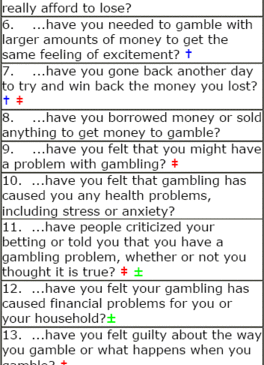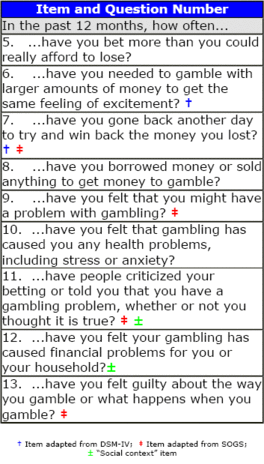As researchers and clinicians continue to unravel the factors that contribute to problem gambling, it is critical for science to develop improved measures for the recognition of unhealthy and pathological gambling. New and modified versions of existing problem gambling scales, such as the shortened South Oaks Gambling Screen (shortened-SOGS, Strong, Breen, Lesieur, & Lejuez, 2003) (see WAGER 8(49) for a full description), are common methods of integrating new knowledge into practice. The Canadian Problem Gambling Index (CPGI, Ferris & Wynne, 2001) is a new instrument designed to assess risky gambling behavior and establish disordered gambling prevalence in general populations. This week, The WAGER looks at the development and testing of the CPGI.
The CPGI contains 31 items that assess various aspects of gambling behavior—this number includes several items adapted from the South Oaks Gambling Screen (SOGS) (Lesieur & Blume, 1987) and DSM-IV (American Psychiatric Association, 1994). A sub-scale of nine items, identified via factor analysis, is scored to provide information on gambling behavior (see Table 1). The remaining 22 items are considered indicators of gambling involvement that could be useful to clinicians in building patient profiles. CPGI respondents endorse the nine scored items on a four-point (Likert-type) severity scale (i.e., never, sometimes, most of the time, almost always) and each level of severity is assigned a matching score (i.e., 0, 1, 2, and 3, respectively). Summed responses generate scores ranging from 0 to 27, with a score of 0 indicating non-problem gambling, 1-2 low-risk gambling, 3-7 moderate risk gambling and 8-27 problem gambling (1).
The authors hypothesized that existing gambling scales might underestimate disordered gambling behaviors in some groups (e.g., women, minorities). To accommodate such groups the authors designed several CPGI items (both scored and unscored) to assess a respondent’s gambling behaviors in relation to his or her social environment (see Table 1). These items provide an additional tool to clinicians in assessing an individual’s personal risk of developing disordered gambling behavior because social environment indicators provide information about a respondent’s finances and personal relationships that other types of questions do not.
Table 1. Scored CPGI items (Ferris & Wynne, 2001)
Ferris and Wynne (2001) developed the CPGI in part by conducting a general population study of a random sample of Canadian adults. In order to test the dimensionality of the measure, the authors performed a series of factor analyses on the respondents’ answers to the 31 CPGI items. A final factor analysis revealed a nine-item (i.e., the nine items listed in Table 1) unifactorial model (i.e., the nine items correlated highly with each other to produce one scale measuring gambling behavior) fit best, explaining 38.3% of the variation in the data. This version of the CPGI showed high internal consistency (i.e., the nine items were highly correlated) and reliability over time (i.e., respondents answered the questions similarly at two different time points). Respondents in the general population study answered SOGS (Lesieur & Blume, 1987), DSM-IV (American Psychiatric Association, 1994) pathological gambling criteria items and original CPGI items similarly, suggesting that prevalence estimates from all three instruments would be also be similar.
There are several limitations to the CPGI. First, it is designed to measure gambling behaviors only in general populations. While this is not problematic in itself, recent research suggests that targeted vulnerable population studies might prove more useful in advancing the science of predicting gambling behaviors and promoting recovery (Shaffer, LaBrie, LaPlante, Nelson, & Stanton, in press).
Further, the scored portion of the CPGI contains several items adapted from the SOGS and DSM-IV (see Table 1). The inclusion of SOGS and DSM-IV items likely explains the CPGI’s high correlation with these instruments and calls into question the CPGI’s value as a purely independent measure. In addition, the report did not include specific details about CPGI-generated socioeconomic profiles of gamblers in the general population study—this precludes comment on the CPGI’s ability to determine gambling vulnerability among disadvantaged populations. Finally, because the CPGI is a relatively new instrument, it has not yet been subjected to the rigors of widespread academic use. Until further research is conducted using the CPGI, clinicians employing the scale should exercise caution in interpreting results.
The development of new problem gambling scales, such as the CPGI, represents a noteworthy advancement in the field of gambling treatment and recovery. While, over time, groundbreaking instruments such as the SOGS and DSM-IV criteria for pathological gambling have proven valid and reliable measures of problem gambling behaviors, new instruments can benefit researchers by incorporating the latest theories into practice. In the case of the CPGI, emphasis on environmental and social elements that could contribute to disordered gambling—an area not thoroughly explored by other measures—could prove especially useful to clinicians in developing patient profiles. Although it is only one component of gambling research, improved instrumentation is vital to the advancement of our understanding of gambling and its consequences.
Next week, The WAGER will continue our discussion of the CPGI with a review of a report of a recent Canadian study that utilized the CPGI to generate national gambling prevalence estimates.
Comments on this article can be addressed to Tony Donato.
Notes
1 The authors define the CPGI gambling groups as follows:
non-problem gambling = respondent experiences no adverse consequences of gambling, no distorted cognition items
low-risk gambling = respondent experiences no adverse consequences of gambling, but responded affirmatively to two or more indicators of problem gambling
moderate-risk gambling = respondent may or may not experience adverse consequences of gambling, and responded affirmatively to three or four indicators of problem gambling
problem gambling = respondent experiences adverse consequences of gambling and may have lost control of gambling behavior; respondent responded affirmatively to multiple indicators of problem gambling and cognitive distortion items.
References
American Psychiatric Association. (1994). DSM-IV: Diagnostic and statistical manual of mental disorders (Fourth ed.). Washington, D.C.: American Psychiatric Association.
Ferris, J., & Wynne, H. (2001). The Canadian Problem Gambling Index: Final report. Ottawa: Canadian Centre on Substance Abuse.
Lesieur, H. R., & Blume, S. B. (1987). The South Oaks Gambling Screen (SOGS): A new instrument for the identification of pathological gamblers. American Journal of Psychiatry, 144(9), 1184-1188.
Shaffer, H. J., LaBrie, R. A., LaPlante, D., Nelson, S., & Stanton, M. (in press). The road less traveled: Moving from distribution to determinants in the study of gambling epidemiology. Canadian Journal of Psychiatry.
Strong, D. R., Breen, R. B., Lesieur, H. R., & Lejuez, C. W. (2003). Using the Rasch model to evaluate the South Oaks Gambling Screen for use with nonpathological gamblers. Addictive Behaviors, 28, 1465-1472.





